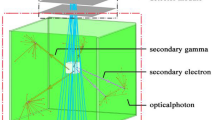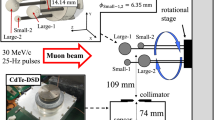Abstract
Muon tomography is a novel method for the non-destructive imaging of materials based on muon rays, which are highly penetrating in natural background radiation. Currently, the most commonly used imaging methods include muon radiography and muon tomography. A previously studied method known as coinciding muon trajectory density tomography, which utilizes muonic secondary particles, is proposed to image low and medium atomic number (Z) materials. However, scattering tomography is mostly used to image high-Z materials, and coinciding muon trajectory density tomography exhibits a hollow phenomenon in the imaging results owing to the self-absorption effect. To address the shortcomings of the individual imaging methods, hybrid model tomography combining scattering tomography and coinciding muon trajectory density tomography is proposed and verified. In addition, the peak signal-to-noise ratio was introduced to quantitatively analyze the image quality. Different imaging models were simulated using the Geant4 toolkit to confirm the advantages of this innovative method. The simulation results showed that hybrid model tomography can image centimeter-scale materials with low, medium, and high Z simultaneously. For high-Z materials with similar atomic numbers, this method can clearly distinguish those with apparent differences in density. According to the peak signal-to-noise ratio of the analysis, the reconstructed image quality of the new method was significantly higher than that of the individual imaging methods. This study provides a reliable approach to the compatibility of scattering tomography and coinciding muon trajectory density tomography.







Similar content being viewed by others
References
S.H. Neddermeyer, C.D. Anderson, Cosmic-ray particles of intermediate mass. Phys. Rev. 54, 88 (1938). https://doi.org/10.1103/PhysRev.54.88.2
M. Tanabashi, P.D. Grp, K. Hagiwara et al., Review of particle physics: Particle data group. Phys. Rev. D. 98, 030001 (2018). https://doi.org/10.1103/PhysRevD.98.030001
L.W. Alvarez, J.A. Anderson, F.E. Bedwei et al., Search for hidden chambers in the pyramids. Science 167, 3919 (1970). https://doi.org/10.1126/science.167.3919.832
V. Tioukov, A. Alexandrov, C. Bozza et al., First muography of stromboli volcano. Sci. Rep. 9, 6695 (2019). https://doi.org/10.1038/s41598-019-43131-8
R. Han, Q. Yu, Z. Li et al., Cosmic muon flux measurement and tunnel overburden structure imaging. J. Instrum. 15, P06019 (2020). https://doi.org/10.1088/1748-0221/15/06/P06019
R. Nishiyama, A. Ariga, T. Ariga et al., First measurement of ice-bedrock interface of alpine glaciers by cosmic muon radiography. Geophys. Res. Lett. 44, 12 (2017). https://doi.org/10.1002/2017GL073599
K. Morishima, M. Kuno, A. Nishio et al., Discovery of a big void in khufu’s pyramid by observation of cosmic-ray muons. Nature 552, 387–401 (2017). https://doi.org/10.1038/nature24647
K.N. Borozdin, G.E. Hogan, C. Morris et al., Surveillance: radiographic imaging with cosmic-ray muons. Nature 422, 277–279 (2003). https://doi.org/10.1038/422277a
S. Tripathy, J. Datta, A. Jash et al., Material identification with cosmic ray muons using RPCs. J. Instrum. 14, C07007 (2018). https://doi.org/10.1088/1748-0221/14/07/C07007
S. Xiao, W.B. He, M.C. Lan et al., A modified multi-group model of angular and momentum distribution of cosmic ray muons for thickness measurement and material discrimination of slabs. Nucl. Sci. Tech. 29, 28 (2018). https://doi.org/10.1007/s41365-018-0363-7
C.M. Liu, Q.G. Wen, Z.Y. Zhang et al., Study of muon tomographic imaging for high-Z material detection with a micromegas-based tracking system. Radiat. Detect. Technol. Methods 4, 263–268 (2020). https://doi.org/10.1007/s41605-020-00179-9
C.L. Morris, C.C. Alexander, J.D. Bacon et al., Tomographic imaging with cosmic ray muons. Sci. Glob. Secur. 16, 37–53 (2008). https://doi.org/10.1080/08929880802335758
X. Wang, M. Zeng, Z. Zeng et al., The cosmic ray muon tomography facility based on large scale MRPC detectors. Nucl. Instrum. Meth. A 784, 390 (2015). https://doi.org/10.1016/j.nima.2015.01.024
Z.W. Pan, J.Y. Dong, X.J. Ni et al., Conceptual design and update of the 128-channel μSR prototype spectrometer based on musrSim. Nucl. Sci. Tech. 30, 123 (2019). https://doi.org/10.1007/s41365-019-0648-5
X.Y. Pan, Y.F. Zheng, Z. Zeng et al., Experimental validation of material discrimination ability of muon scattering tomography at the TUMUTY facility. Nucl. Sci. Tech. 30, 120 (2019). https://doi.org/10.1007/s41365-019-0649-4
X.L. Qian, H.Y. Sun, C. Liu et al., Simulation study on performance optimization of a prototype scintillation detector for the GRANDProto35 experiment. Nucl. Sci. Tech. 32, 51 (2021). https://doi.org/10.1007/s41365-021-00882-2
Z.Y. Li, Y.M. Zhang, G.F. Cao et al., Event vertex and time reconstruction in large-volume liquid scintillator detectors. Nucl. Sci. Tech. 32, 49 (2021). https://doi.org/10.1007/s41365-021-00885-z
P.L. Rocca, V. Antonuccio, M. Bandieramonte et al., Search for hidden high-Z materials inside containers with the muon portal project. J. Instrum. 9, C01056 (2013). https://doi.org/10.1088/1748-0221/9/01/C01056
J. Armitage, J. Botte, K. Boudjemline et al., First images from the cript muon tomography system. Int. J. Mod. Phys. Conf. Ser 27, 1460129 (2014). https://doi.org/10.1142/S201019451460129X
G. Blanpied, S. Kumar, D. Dorroh et al., Material discrimination using scattering and stopping of cosmic ray muons and electrons: Differentiating heavier from lighter metals as well as low-atomic weight materials. Nucl. Instrum. Meth. A 784, 352–358 (2015). https://doi.org/10.1016/j.nima.2014.11.027
K. Borozdin, S. Greene, Z. Lukic et al., Cosmic ray radiography of the damaged cores of the fukushima reactors. Phys. Rev. Lett. 109, 152501 (2012). https://doi.org/10.1103/physrevlett.109.152501
E. Guardincerri, J. Bacon, K. Borozdin et al., Detecting special nuclear material using muon-induced neutron emission. Nucl. Instru. and Meth. A 789, 109–113 (2015). https://doi.org/10.1016/j.nima.2015.03.070
T.B. Blackwell, V.A. Kudryavtsev, Simulation study into the identification of nuclear materials in cargo containers using cosmic rays. J. Instrum. 10, T04003 (2015). https://doi.org/10.1088/1748-0221/10/04/T04003
H.Y. Lan, T. Song, J.L. Zhang et al., Rapid interrogation of special nuclear materials by combining scattering and transmission nuclear resonance fluorescence spectroscopy. Nucl. Sci. Tech. 32, 84 (2021). https://doi.org/10.1007/s41365-021-00914-x
I. Bikit, D. Mrdja, K. Bikit et al., Novel approach to imaging by cosmic-ray muons. Europhysics Lett. 113, 58001 (2016). https://doi.org/10.1209/0295-5075/113/58001
D. Mrdja, I. Bikit, K. Bikit et al., First cosmic-ray images of bone and soft tissue. Europhysics Lett. 116, 48003 (2016). https://doi.org/10.1209/0295-5075/116/48003
G. Galgoczi, D. Mrdja, I. Bikit et al., Imaging by muons and their induced secondary particles—a novel technique. J. Instrum. 15, C06014 (2020). https://doi.org/10.1088/1748-0221/15/06/C06014
X.T. Ji, S.Y. Luo, Y.H. Huang et al., A novel 4D resolution imaging method for low and medium atomic number objects at the centimeter scale by coincidence detection technique of cosmic-ray muon and its secondary particles. Nucl. Sci. Tech. 33, 2 (2022). https://doi.org/10.1007/s41365-022-00989-0
D.I.M. Setiadi, PSNR vs SSIM: imperceptibility quality assessment for image steganography. Multimed Tools Appl. 80, 8423–8444 (2021). https://doi.org/10.1007/s11042-020-10035-z
S. Agostinelli, J. Allison, K. Amako et al., GEANT4 collaboration, GEANT4 — a simulation toolkit. Nucl. Instrum. Meth. A 506, 250–303 (2003). https://doi.org/10.1016/S0168-9002(03)01368-8
J. Feng, Z. Zhang, J. Liu et al., A thermal bonding method for manufacturing micromegas detectors. Nucl. Instru. and Meth. A 989, 164958 (2020). https://doi.org/10.1016/j.nima.2020.164958
C. Hagmann, D. Lange, D. Wright, Cosmic-ray shower generator (CRY) for Monte Carlo transport codes. IEEE Nucl. Sci. Symp. Conf. Rec. 2, 1143–1146 (2007). https://doi.org/10.1109/NSSMIC.2007.4437209
A.G. Bogdanov, H. Burkhardt, V.N. Ivanchenko et al., Geant4 simulation of production and interaction of muons. IEEE Trans. Nucl. Sci. 53, 513–519 (2006). https://doi.org/10.1109/TNS.2006.872633
Author information
Authors and Affiliations
Contributions
All authors contributed to the study conception and design. Material preparation, data collection, and analysis were performed by Si-Yuan Luo, Yu-He Huang, Xuan-Tao Ji, Lie He, and Xiao-Dong Wang. The first draft of the manuscript was written by Si-Yuan Luo, and all authors commented on previous versions of the manuscript. All authors read and approved the final manuscript.
Corresponding author
Additional information
This work was supported by the National Natural Science Foundation of China (No. 11875163), Natural Science Foundation of Hunan Province (Nos. 2021JJ20006 and 2021JJ40444), Ministry of Science and Technology of China (No. 2020YFE0202001), and Department of Education of Hunan Province (Nos. 19B488 and 21A0281).
Rights and permissions
About this article
Cite this article
Luo, SY., Huang, YH., Ji, XT. et al. Hybrid model for muon tomography and quantitative analysis of image quality. NUCL SCI TECH 33, 81 (2022). https://doi.org/10.1007/s41365-022-01070-6
Received:
Revised:
Accepted:
Published:
DOI: https://doi.org/10.1007/s41365-022-01070-6




